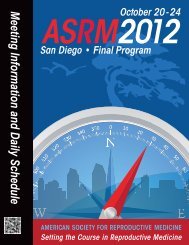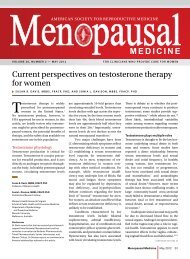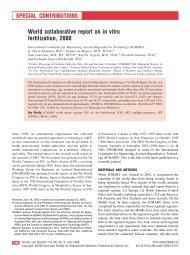scientific program • symposia - American Society for Reproductive ...
scientific program • symposia - American Society for Reproductive ...
scientific program • symposia - American Society for Reproductive ...
Create successful ePaper yourself
Turn your PDF publications into a flip-book with our unique Google optimized e-Paper software.
VIDEO PROGRAM<br />
Tuesday, October 18, 2011 4:15 pm – 6:15 pm<br />
ASRM Video Session II<br />
REPRODUCTIVE SURGERY<br />
Moderators: TBD<br />
V-11 4:20 PM<br />
LAPAROSCOPIC ASSISTED MYOMECTOMY.<br />
M. Catenacci, M. Attaran, T. Falcone. Cleveland Clinic<br />
Foundation, Cleveland, OH.<br />
OBJECTIVE: The objective of this video is to demonstrate our<br />
technique <strong>for</strong> a laparoscopic assisted myomectomy.<br />
DESIGN: Laparoscopic assisted myomectomy uses three<br />
5 mm traditional laparoscopic ports and a Gelpoint<br />
laparoscopic port <strong>for</strong> the minilaparotomy incision. The<br />
fibroid(s) is enucleated from the uterus using traditional<br />
laparoscopic technique. Dilute vasopressin is first injected<br />
subserosally. A monopolar hook or Harmonic scalpel is<br />
then used to incise the serosa over the myoma. Sharp and<br />
blunt dissection is used to remove the fibroid from its uterine<br />
attachment. The fibroid is then morcellated through the<br />
minilaparotomy incision and the myometrial defect is then<br />
closed.<br />
MATERIALS AND METHODS: Laparoscopic assisted<br />
myomectomy offers benefits of both abdominal and<br />
laparoscopic procedures with an overall decrease in<br />
operative time, quicker patient recovery and an open<br />
closure of the myometrial defect. The Gelpoint laparoscopic<br />
port can be useful as it allows <strong>for</strong> easy conversion between<br />
laparoscopy and laparotomy.<br />
__________________________________________________________<br />
V-12 4:26 PM<br />
ROBOTIC MYOMECTOMY WITH FLEXIBLE CO2 LASER.<br />
A. R. Gargiulo. Center <strong>for</strong> Infertility and <strong>Reproductive</strong><br />
Surgery, Brigham and Women’s Hospital/Harvard Medical<br />
School, Boston, MA.<br />
OBJECTIVE: We describe the use of a flexible carbon<br />
dioxide (CO2) laser system recently made commercially<br />
available by OmniGuide (Cambridge, Massachusetts) in<br />
the management of uterine fibroids in a robot-assisted<br />
procedure. Conventional optic fibers transmit light through a<br />
solid core whereas the novel flexible fibers employed in this<br />
case have a hollow core.<br />
DESIGN: The patient was a 35 year old with menorrhagia<br />
and pelvic pain. The CO2 laser was the only <strong>for</strong>m of thermal<br />
energy employed in this case to enucleate a 7 transmural<br />
and a 4 cm subserosal myoma. An 8 mm robotic needle<br />
driver was used to grasp the 2 mm laser fiber introducer.<br />
The design of the delivery system also assisted with blunt<br />
tissue dissection. The OmniGuide delivery system was set to<br />
create a cutting beam at a distance of 2-3 mm from the<br />
tip of the device to the tissue. A low flow of helium gas was<br />
delivered through the hollow core of the fiber effectively<br />
dried the target tissue, enhancing the laser hemostatic<br />
effect. A relevant safety feature of this CO2 laser system<br />
was the absence of plume. The laser also allowed easy<br />
excision of an area of peritoneum with endometriosis.<br />
For this application, we used the system at a low power,<br />
allowing tissue penetration under 500 microns. There were<br />
no complications.<br />
MATERIALS AND METHODS: Our initial experience suggests<br />
that the introduction of a truly flexible, fiber-based CO2 laser<br />
Chapin Theatre<br />
98<br />
to robotic gynecologic surgery presents opportunities to<br />
bring a higher level of precision to a variety of reproductive<br />
surgery applications. The ability to bend the laser delivery<br />
system in any direction works particularly well in combination<br />
with the expanded degree of motion freedom allowed<br />
by robotic plat<strong>for</strong>ms. Furthermore, the three-dimensional<br />
vision, high accuracy and absence of tremor that is typical<br />
of robotic surgery may allow a level of laser safety that is<br />
superior to that observed in conventional laparoscopy.<br />
Acknowledgement: less than 25% of this video is comprised<br />
of commercial video/photo material.<br />
__________________________________________________________<br />
V-13 4:40 PM<br />
LAPAROSCOPIC BILATERAL GONADECTOMY FOR ANDROGEN<br />
INSENSITIVITY SYNDROME.<br />
M. S. Miller, R. W. Naumann, R. S. Usadi. OB/GYN, Carolinas<br />
Medical Center, Charlotte, NC.<br />
OBJECTIVE: Androgen Insensitivity Syndrome is a disorder<br />
of sexual development caused by a defect in androgen<br />
receptor function. This defect inhibits the virilization of<br />
46, XY males despite the presence of testes and normal<br />
testosterone production. The complete <strong>for</strong>m of androgen<br />
insensitivity results in a phenotypic female with a short<br />
vaginal pouch, absent uterus and tubes, absent pubic hair,<br />
and normal breast development. Testes are present, but<br />
often abnormally positioned in the inguinal canals. The main<br />
risk associated with cryptorchidism is the development of<br />
gonadal tumors, particularly gonadoblastoma. Treatment<br />
consists of gonadectomy per<strong>for</strong>med between ages<br />
16-18, postoperative estrogen therapy, and referral to<br />
psychological and genetic counseling. Traditionally,<br />
gonadectomies have been per<strong>for</strong>med through large<br />
abdominal incisions. There are several case studies that<br />
document successful laparoscopic gondectomies in<br />
individuals with complete androgen insensitivity syndrome.<br />
This eliminates the need <strong>for</strong> laparotomy and results in<br />
more rapid recovery, shorter less expensive hospital stays,<br />
and decreased blood loss. This short film presents the<br />
laparoscopic gonadectomy of a 17 year old phenotypic<br />
female with complete androgen insensitivity syndrome.<br />
DESIGN: Video.<br />
MATERIALS AND METHODS: Laparoscopy is a safe and<br />
effective method <strong>for</strong> gonadectomy in individuals<br />
with androgen insensitivity syndrome and associated<br />
cryptorchidism.<br />
__________________________________________________________<br />
V-14 4:47 PM<br />
LAPAROSCOPIC GONADECTOMY IN ANDROGEN<br />
INSENSITIVITY SYNDROME.<br />
J. Kim, N. Craw<strong>for</strong>d, S. Patel, S. Kehoe, O. Tan, B. Carr.<br />
Department of Ob/Gyn, University of Texas Southwestern<br />
Medical Center, Dallas, TX.<br />
OBJECTIVE: Androgen insensitivity syndrome (AIS), a<br />
X-linked recessive disorder, is the most common <strong>for</strong>m of<br />
male disorders of sex development occurring in 1/20000<br />
genetic male. Due to mutations on the androgen<br />
receptor gene, patients are subject to varying degrees<br />
of undermasculinization despite the presence of normal<br />
androgen production by the testes and peripheral








